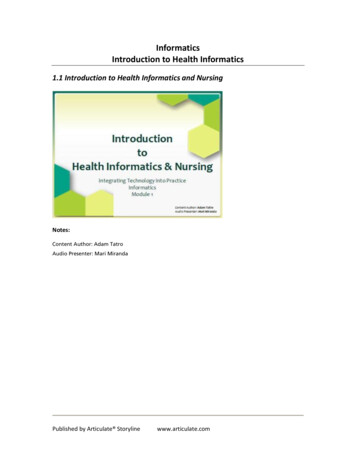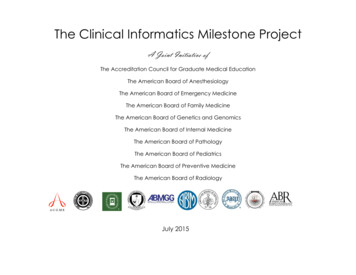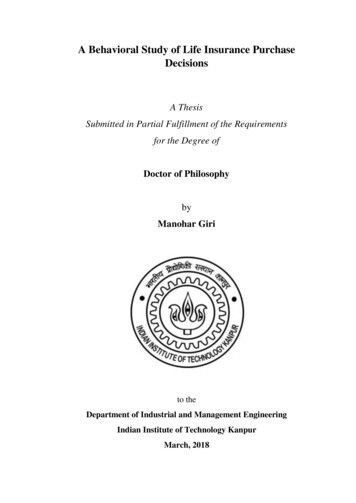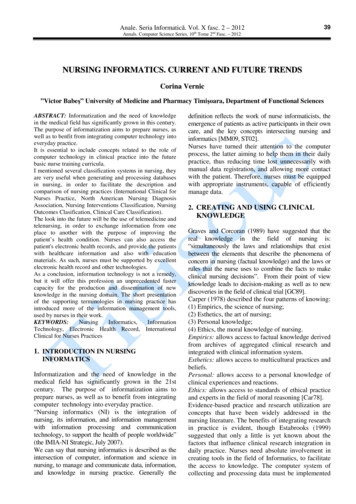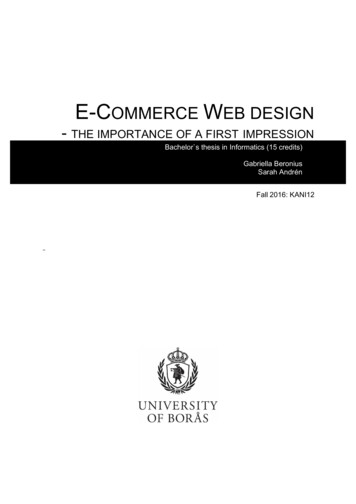
Transcription
E-COMMERCE WEB DESIGN- THE IMPORTANCE OF A FIRST IMPRESSIONBachelor s thesis in Informatics (15 credits)Gabriella BeroniusSarah AndrénFall 2016: KANI12
Title: E-Commerce Web design – The importance of a first impressionYear: 2016Authors: Gabriella Beronius, Sarah AndrénSupervisor: Peter RittgenAbstractThe technical society we live in is in a constant state of advancement and we are continuallyintroduced to new innovative ways of mediating information through. Today, plenty of mediachannels exist, for organizations to use when they strive to reach larger groups of people, butto achieve web site success; researchers have stated that considerations of user preferencesimplemented in web design are crucial. This makes understanding and addressing whichcharacteristics will be valued from the moment a user enters a site something that isconsidered helpful to the web designer in order to maintain user traffic and create an interest.In other words, something to catch the user’s attention to create a good first impression isnecessary.The constant state of advancement of technology prevailing today has resulted in even morecomplex websites and a countless number of design principles to apply when designing forthe web. In spite of this, usability and visual appeal have remained central in prior research.To test these theories, a study was conducted by using a qualitative method in form of anexperiment consisting of eye tracking and an open-ended questionnaire. To perform the eyetracking the researchers created two mock-ups representing the main page of two differentwebsites. Each mock-up was developed with considerations towards two different designapproaches, one striving to achieve visual appeal and the other towards usability, todetermine which one the participants preferred.The study contained 50 participants who performed the experiment and answered thequestionnaire. Results from the eye tracking were presented in gaze plots and heat maps andthe result from the questionnaire was presented and analyzed through coding by theresearchers.Final findings showed that the website preferred by most participants were the one developedwith the usable design approach. Additionally, the discussion presented the findings andreaches a conclusion of the study which finds connections between the chosen designapproach of the webpage and the participant’s choice of preferred webpage.Keywords: First impression, perceived usability, web design, eye-tracking, visual appeal
AcknowledgementsFirst, we would like to thank our supervisor Peter Rotten for his assistance and guidanceduring the progression of this thesis.We would also like to show our gratitude to Camilla Carlson at SIIR, for making it possiblefor us to perform our experiment and for all her support.A big thank you is also directed to Grazette of Sweden for their sponsorship of gifts that weregiven to the participants.And finally, we would like to thank all the participants who helped us by participating in theexperiment.
Table of content11.11.21.31.41.51.61.7INTRODUCTION. 1PREVIOUS RESEARCH . 1PROBLEM STATEMENT . 2PURPOSE OF STUDY . 3RESEARCH QUESTION . 3DELIMITATIONS . 3TARGET GROUP . 4DISPOSITION . 42THEORY . 52.1DESIGNING WEBSITES . 52.1.1E-Commerce websites . 62.1.2Usability on websites . 72.1.3Graphical design on websites. 72.2USER INTERPRETATION AND PERCEPTION OF WEBSITES . 82.2.1Aesthetics . 92.2.2First impression . 92.3INTERACTION WITH A WEBSITE . 102.3.1Eye-tracking and eye-movements . 102.3.2Glance-attracting objects and attention . 112.3.3Memory and recognition . 113METHODOLOGY . 123.1RESEARCH STRATEGY . 123.2RESEARCH APPROACH. 123.3RESEARCH PROCESS. 133.4RESEARCH DESING . 143.4.1Design of mock-ups . 153.4.2Design of questionnaire. 163.5IMPLEMENTATION OF EMPIRICAL RESEARCH . 173.5.1Pilot experiment . 173.5.2Learning points from pilot experiment . 183.5.3Implementation of experiment . 193.6ETHICAL ISSUES . 193.6.1Harm to participants . 203.6.2Informed consent . 203.7COLLECTION OF THEORY . 213.8DATA ANALYZING . 213.9SAMPLING METHOD . 2244.14.2EMPIRICAL FINDINGS . 24EYE-TRACKING RESULTS . 24QUESTIONNAIRE RESULTS . 2955.15.25.3DISCUSSION . 37GAZING PATTERNS . 37AREAS OF INTRESST . 38USER PREFERENCES . 3866.16.26.3CONCLUSION . 40CONTRIBUTION TO THE AREA OF INFORMATICS . 41EVALUATION OF METHOD . Error! Bookmark not defined.FUTURE RESEARCH . 41
Figure 1, Research process . 14Figure 2 Heat gradient . 24Figure 3. Heat map after 50 milliseconds after first instructions. Mock-up 1 to the left and Mock-up 2 to theright. .25Figure 4. Heat map after 10 seconds after first instructions. Mock-up 1 to the left and Mock-up 2 to the right. 26Figure 5 Heat map after 5 seconds after second instructions. Mock-up 1 to the left and Mock-up 2 to the right. 27Figure 6 Gaze plot after 50 milliseconds after first instructions. Mock-up 1 to the left and Mock-up 2 to the right. 28Figure 7 Gaze plot after 10 seconds after first instructions. Mock-up 1 to the left and Mock-up 2 to the right. 28Figure 8 Gaze plot after 5 seconds after second instructions. Mock-up 1 to the left and Mock-up 2 to the right. 29Figure 9 Presents the age spread in the experiment . 29Figure 10.Presents the users shopping habits where frequently are associated with more than once a mount,Occasionally associates with once a mount, and rarely associates with participants who shops once every threemounts or less. . 30Table 1 Headline explanation. 30Table 2 Describe your first impression of the webpage. Was it good or bad? Please motivate your answer . 30Table 3 Can you write down two things you remembered from the webpage? . 31Table 4 What navigation tools did you find on the webpage? . 32Table 5 Did you experience the web page to be easy to use? . 32Table 6 Did you understand what the webpage was selling? . 33Table 7 Describe your first impression of the webpage. Was it good or bad? Please motivate your answer . 33Table 8 Can you write down two things you remembered from the web page? . 34Table 9 What navigation tools did you find on the webpage? . 35Table 10 Did you experience the web page to be easy to use? . 35Table 11 Did you understand what the webpage was selling?. 36Table 12 Which web page did you prefer the first one or the second one? Please motivate your answer. . 36
1 INTRODUCTIONThis chapter will acquaint the reader with the concepts: Generation Y, usability, and aesthetics,which will be appearing continuously through this paper. The reader will also become aware ofthe researchers view of the importance of understanding website requirements from largesegments existing on the Swedish online market.The internet usage in Sweden is increasing for every year and during 2015, 93% of theSwedish population reported that they had internet access, a spread also shown to have a largeimpact on the Swedish market by a remarkable increase in annual turnovers (Svenskar ochInternet 2015). A specific case is the online clothing industry of Sweden, which alone wasreported to have a turnover of 8.3 billion SEK 2015 (Svenskar och Internet 2015).Today, there are few organizations that are not represented with a website and as a tool toreach out to larger groups many also choose to develop web shops (The Swedish bureau ofStatistics). This has resulted in a large selection of electronic commerce websites, ore-commerce websites (i.e. an online marketplace selling products or services) and due tocompetition where good web design is considered a key to success and a way to compete.So, the question is: What is good web design?There are plenty of theories to find of what design principle to use when wanting to create agood e-commerce website and among these are the philosophical study of beauty and tasteand the ease of use and learnability. In other words, aesthetics and usability. These two designapproaches are central in the context of web design when the target is to achieve success,which is derived by pleasing the user by understanding them, their preferences and theirneeds (Beaird 2010; Michailidou, Harper & Bechhofer 2008; Azam 2015).In Sweden, the most active segment of e-consumers (e.g. consumers who shop for products orservices online) were reported to be women between the ages of 18 and 29 and out of allyoung female e-consumers, 60% were reported shopping especially for clothes (E-barometernQ3 2015; E-barometern helårsrapport 2015). Judging from this information, young womenbetween those ages should be the targeted audience when you operate an e-commerce websiteselling clothes. What remains unspoken though is how the stated design approaches above areperceived and valued when presented to that specific segment.1.1 Previous ResearchHuman-computer interaction is a subject concerning several areas of research and hascontributed to the evolution of beneficial solutions for users where the common goal is tofacilitate the interaction between them and the system (Ghaoui 2006). Among the areas ofresearch concerning interactive systems such as e-commerce websites, aspects in graphicaldesign and business are mentioned by stressing the importance of keeping the user satisfied toachieve a successful business as well as a good web design (Garrett 2011).To design an interface of a website that is perceived to be attractive by the users is on theother hand expressed as a challenge in prior studies (Djamasbi, Siegel, Tullis, Skorinko 2011;Bonnardel et al. 2010). But from the research performed by Djamasbi, Siegel, Tullis andSkorinko (2011) certain common characteristics were found especially within the segment of,1
“Generation Y” which refers to individuals between the ages 18 and 31.These characteristics were detected by using an eye-tracking device. Eye-tracking is describedas “a usability testing technique that provides a visual overlay of where visitors mostcommonly look at on the screen (heat maps) and individual or common paths (gaze trails)”(Chaffey 2011, s.601). The eye-tracker provides the researcher with detailed informationabout how a user interacts with a specific interface elements (Cyr, Head & Larios 2010) byidentifying areas where the individual pays his or her attention (Sari, Ferdiana, Santosa &Nugroho 2015).The outcome of the performed experiment in the study by Djamasbi, Siegel, Tullis &Skorinko (2011) showed that the younger generation of users had become less interested inmassive texts and multiple pictures and does instead require quick information gathering,recognition and fast impressions.Per Lindgaard, Fernandes, Dudek & Brown (2006): “You have about 50 milliseconds toestablish a first impression”. The first impression is another aspect discussed in the context ofretaining users at websites as it has been proved to contribute to the user’s choice ofremaining at a site. It has also been discussed that the way you perceive the website from thefirst glance, positively or negatively, will affect the way a user interprets the entire contentthey are exposed to (Lindgaard & Dudek 2002; Garrett 2011).1.2 Problem statementThe design of a website is highly dependent and controlled by the targeted audience andintended purpose, which means that the content needs to be mediated in a way that it will bepositively perceived by the recipient (Chaffey 2011). In order to accomplish that, you alsoneed to know who the target may be.Regarding consumers operating on the e-commerce market in Sweden, four out of ten ecommerce consumers reported that they had bought clothes online (E-barometernhelårsrapport 2015). The same report also showed that 60% of all young women (i.e. ages 1830) who purchase products online were especially shopping for clothes, which indicates aquite large subset. But when searching for documentations investigating specifically thatsegment and their preferences in web design, little were to be found apart from the researchconducted by Djamasbi, Siegel, Tullis and Skorinko (2011) and Djamasbi, Siegel, Tullis(2010) where the target were to specifically capture the characteristics contributing to whatthe female and male users in the specified ages, perceived to be visually appealing (e.g. theuser’s aesthetical evaluation of a web page). What remains unclear, is how the investigatedsegment value usability aspects, which is mentioned in their research but did not dug furtherinto.When prior studies stressed the importance of keeping the user central in the design process ofa website (independent on age), both aesthetical and usability aspects are mentioned. Though,there has been deviations in the how the researchers described the importance of them inrelation to each other. Some explained that a combination of both were necessary to claimuser interest and to maximize the website quality (Eccher 2014; Beaird 2010), while othersstressed that the aesthetics had gained more importance and that bad usability had a tendency2
of being overlooked when a website was considered visually pleasing (Djamasbi, Siegel,Tullis & Skorinko 2011; Lindgaard & Dudek 2002; Lindgaard, Fernandes, Dudek & Brown2006).It all seems to imply to the importance of the users first impression and the understanding ofhow the website should be designed to be valued in their eyes. But as there exists dividedsentences in how to prioritize the web design, it urges for a gap necessary to fill in tounderstand if the advancement in technology in some way have affected the youngergeneration (referred to as people between the ages 18-35 during this thesis), their preferencesand perception of e-commerce websites.1.3 Purpose of StudyThe goal when you create a website is to make sure that people find it interesting enough tostay at your site. One step towards achieving that is to understand the users and what theyrequire from you. Therefore, this study seeks to understand the preferences of females borninto the younger generations as they are a large segment highly relevant for an e-commercewebsite to understand if striving to achieve website success in Sweden.The aim is towards gaining an understanding of where a user look when entering a main pagefor the first time to determine areas of interest and certain focal points. But also, to search fora certain pattern reflecting the characteristics that distinguish between attitudes of web pages,and why the users prefer one site over another.1.4 Research QuestionWith an attempt to fill the gap of how to design websites in order to attract and retain femaleusers of younger generations from the moment they are entering an e-commerce website, theresearchers strive towards contributing with further knowledge to the subject Humancomputer interaction and web design. The following research question were established:What considerations need to be made when shaping the young user’s first impression of themain page of an e-commerce website?To narrow down the main research question of this study, the decision of developing two subquestions were made:1. Will usability highly valued in a pre-usage state when the user is shaping her firstimpression?2. Will young users prefer a web design with more graphical considerations?1.5 DelimitationsFor this research, focus has been chosen to be towards the structure of the main page withvisual as well as usable considerations.3
The researchers therefore have chosen to make delimitation when it comes to measurementsof usability consisting of task performance and learning time through a live website and willinstead investigate the perceived usability by creating static images. The researchers have alsochosen to limit their research to e-commerce websites selling clothes to get a more focusedresearch. Finally, the geographic area of research will be delimited to the Swedish city Boråswhere equipment necessary for the study will be available.1.6 Target GroupThe hopes are to provide an initial idea of the preferences and values of a part of the majorsegment operating on the e-based market of Sweden and to contribute with additionalknowledge within the subject of web design. The findings from this study could be of interestfor individuals or companies developing e-commerce websites reaching out to womenbetween the ages 18 and 35.1.7 DispositionChapter 1Chapter 2Chapter 3Chapter 4Chapter 5Chapter 6This chapter will acquaint the reader with the concepts: Generation Y, usability,and aesthetics, which will be appearing continuously through this paper. Thereader will also become aware of the researchers view of the importance ofunderstanding website requirements from large segments existing on the Swedishonline market.Prior research in Human-Computer interaction with focus on the importance offirst impressions, eye movements and web design are presented in this chapterto provide a theoretical base for the methodology.In this chapter the reader will be introduced to the choice of conducting aqualitative research by implementing an experiment combined with an openended questionnaire. Furthermore the reader will gain an insight of how theresearch proceeded by a flow chart.The results reclaimed from the performed experiment will in this chapter bepresented through two separate parts. Firstly, the results from the eye-trackingwill be introduced followed by an analysis. Secondly, the researchers will present the coding of the answers from the questionnaire.In the discussion, findings reclaimed from the performed experiment will becompared tofindings from prior research mainly directed to the subjects of usability and firstimpression.In this final chapter the researchers will present the answers of the researchquestion and present their contribution to the field of informatics and HumanComputer Interaction.4
2 THEORYPrior research in Human-Computer interaction with focus on the importance of firstimpressions, eye movements and web design are presented in this chapter to provide atheoretical base for the methodology.Human-computer interaction (HCI) is described as a multi-disciplinary subject (Ghaoui 2006;Dix, Finlay, Abowd & Beale 2004), attracting innovation and technology which over the last25 years has been the inspiration for new solutions directed to the benefit of the user as ahuman being (Ghoul 2006). HCI concerns several areas such as psychology, graphicdesign, ergonomics and business among others. The common goal is to make it easier forthe user interacting with a system (Ghaoui 2006; Dix, Finlay, Abowd & Beale 2004).Understanding the users and to make them central in the design of an interactive system iscrucial for many e-based businesses. Partly since users have a tendency of blamingthemselves and feel stupid when the interaction is not running as smoothly as they had hopedto, which gives bad associations with the site (Garrett 2011), but also for a successfulbusiness, considering return of investment (ROI), safety, ethics and sustainability (Benyon2014).In the early 1990s, human-computer interaction established itself as an important area ofstudy about the evolution of the World Wide Web (WWW) (Benyon 2014; Ghaoui 2006). Atthat point of time, the possibility of owning personal computers increased as well as people'sdemands and expectations. This in pace with the starting shot of the rapid change oftechnology (Ghaoui 2006). Today, an interactive system could be a phone, a social network(e.g. Facebook) or, as for this study, an e-commerce web site, which stores and displaysinformation as well as responds to people's actions. (Benyon 2014).2.1 Designing websitesAs an outcome from the rapid increase of technology and new ways of exposinginformation, designers have tended to become overzealous and carried away in their attemptto be creative in their designs (Dawson 2012). The product from this is websites becomingmore complex with an overload of information (Michallidou, Harper & Bechhofer 2008),which as well as a negative impression could entail that the user won't return or use the site(Garrett 2011; Michallidou, Harper & Bechhofer 2008).Per Beaird (2010, s.8) most websites are structured by mainly six components. Container (theframe for the page), logotype (the sites identity), navigation (how the users can use the site),content (anything from images, text or video that can be found on the webpage), footer (thebottom on the page) and white space (areas without illustrations or typing) (Beaird 2010, s.8).For this, web designers use wire frames as a sketch over the page design and a guidance forwhere to place the different elements (Beaird 2010; Lynch & Horton 2009). The structure ofthe wire frame has evolved as a trend and shapes a basis for what is presented as “bestpractice recommendations in web page composition” (Lynch & Horton 2009). Best practice isa praxis origin from research of where on a website a user expects to find certain webelements (Lynch & Horton 2009). Such locations are presented by Eccher (2014) in the book5
“Professional web design” where he explains that the logotype usually is placed at the upperleft corner of the websites as the users are habituated to look there when searching for it.Eccher (2014) also explains that the placement of the navigation is a key component ofefficient web design and that it either should be aligned vertically on the upper area of thepage or descending along with the left side.As web developers are aiming towards making the website components intelligible across allkinds of browsers and to reach the broadest set of consumers, standards for web developmenthave increased their importance (Purwati 2011). The website is a “self-service product” thatcomes without a manual or any further instructions (Garrett 2011) which means that theremust be a consistency in the way you design the website to make it easy for the user tointeract and comprehend with the content they are exposed to (Eccher 2014; Laurence &Tavakol 2007). A key-solution to preventing the users from perceived difficulties is toconstantly be aware of the prevailing design trends and conventions that might aid to reducepossible entry barriers for the users. If they are familiar with a certain structure and recognizethe same characteristics at another web page, the user will find it easier to locate him- orherself around (Dawson 2012). By having these traditional ways of designing the websitelayout in mind, the users will perceive a more natural way of browsing (Dawson 2014).Deviations from the use of the stated standards above may frustrate t
Title: E-Commerce Web design - The importance of a first impression Year: 2016 Authors: Gabriella Beronius, Sarah Andrén Supervisor: Peter Rittgen Abstract The technical society we live in is in a constant state of advancement and we are continually introduced to new innovative ways of mediating information through.


